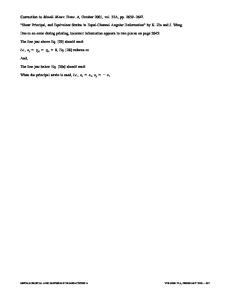Microscale shear specimens for evaluating the shear deformation in single-crystal and nanocrystalline Cu and at Cu–Si in
- PDF / 759,427 Bytes
- 10 Pages / 584.957 x 782.986 pts Page_size
- 79 Downloads / 849 Views
Microscale shear specimens for evaluating the shear deformation in single-crystal and nanocrystalline Cu and at Cu–Si interfaces Jonathan G. Gigax1,a)
, Jon K. Baldwin1, Chris J. Sheehan1, Stuart A. Maloy2, Nan Li1
1
Center for Integrated Technologies, MPA-CINT, Los Alamos National Laboratory, Los Alamos, New Mexico 87545, USA MST-8, Los Alamos National Laboratory, Los Alamos, New Mexico 87545, USA a) Address all correspondence to this author. e-mail: [email protected] 2
Received: 19 September 2018; accepted: 4 March 2019
Microscale testing has enjoyed significant developments, with the majority of testing focused on tensile/ compression type tests and little focus on shear testing. With the recent advances in macroscale shear testing, we developed a novel shear structure for evaluating shear properties of bulk materials and films at the microscale. The shear response in single-crystal copper oriented along the [111] direction was found to have a yield strength of ∼180 MPa. Nanocrystalline copper specimens with different orientations showed sensitivity to the film texture with a shear yield strength nearly three times that of single-crystal copper. Shear specimens were fabricated with Cu film–Si substrate interface near the middle of the shear region and compressed to fracture. The shear response showed a mixed behavior of the stiff Si substrate and softer nanocrystalline film and failed in a brittle manner, indicating a response unique to the interface.
Introduction Microscale mechanical testing is a powerful technique for exploring localized mechanical response of small volumes that facilitates a more detailed analysis of deformation mechanisms, especially when coupled with modeling. Examples of successfully downsized mechanical testing techniques include indentation, compression, tension, and cantilever/bend testing. While some of these techniques feature pure uniaxial compression/tension loading or mixed modes, data from the tests can be used in the determination of shear stresses in a system. For microcompression or microtension tests, the resolved shear stress (RSS) can be calculated provided the knowledge of the specimen orientation with respect to slip planes is known. One phenomenon observed in microscale testing was the increase in yield strength with a decreasing volume, with some of the original experiments reported in Cu [1]. Not all of the increase in yield strengths arise from the same source. In indentation studies, for instance, the higher hardness observed with shallower indentation depth arises from the large strain gradients that give rise to geometrically necessary dislocations [2, 3, 4, 5, 6]. Micromechanical structures (e.g., pillars), on the other hand, showed higher yield strengths and were found to
ª Materials Research Society 2019
come from dislocation starvation or the limited dislocation sources in the test volume [7, 8, 9, 10, 11, 12, 13, 14, 15, 16, 17]. In turn, the calculated RSS from these tests showed a strong size effect, albeit with a trend equivalent to that observed in the no
Data Loading...











